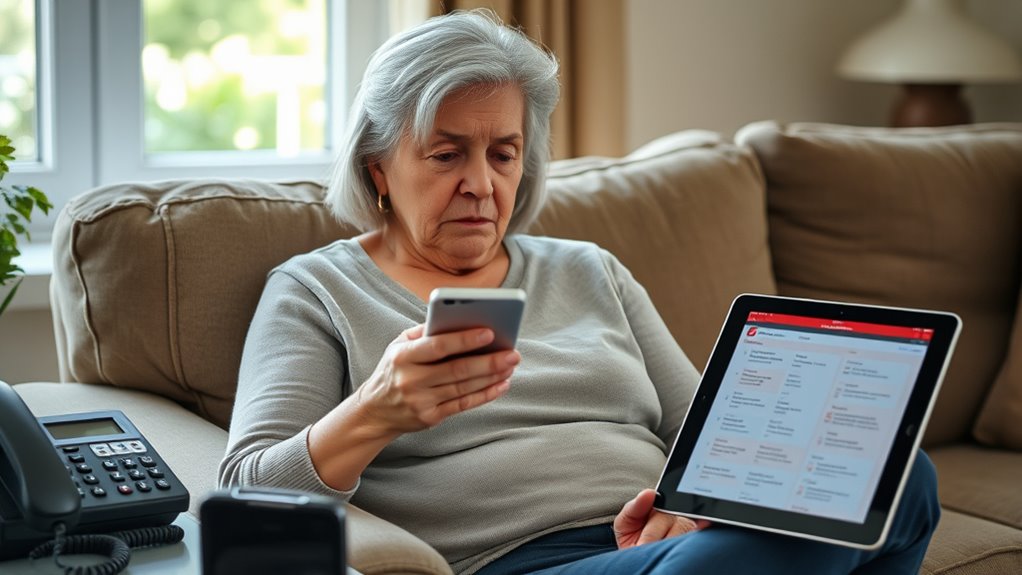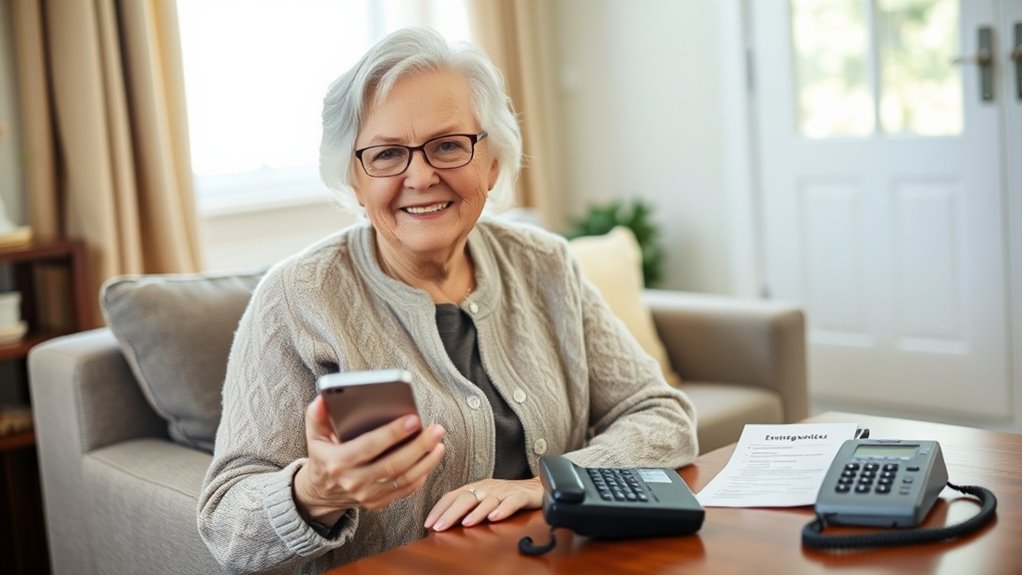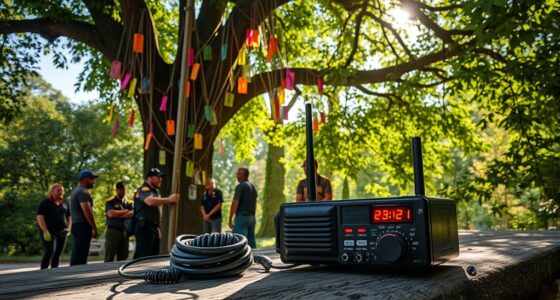To stay connected during emergencies, keep your devices updated with the latest safety apps and security patches. Use features like GPS, emergency buttons, and voice commands for quick response. Join local community groups and neighborhood programs to build trusted contacts and stay informed about alerts. Combining technology with community support creates a strong safety net. Keep exploring to discover more ways to strengthen your emergency communication plan and stay safe.
Key Takeaways
- Develop a multi-channel communication plan using mobile apps, phone trees, and community contacts for reliable emergency updates.
- Keep devices updated with the latest safety features, security patches, and emergency alert apps.
- Familiarize seniors with digital safety practices, including password protection and recognizing scams.
- Engage with local community groups and senior centers for training and real-time safety alerts.
- Combine technology tools with community support networks to ensure quick, effective emergency response and peace of mind.

Have you ever considered how you would stay connected and safe during an emergency? It’s a question that becomes even more crucial as we age, especially when unexpected events occur. Staying informed and maintaining communication can make all the difference in ensuring your safety. One of the most effective ways to do this is by keeping up with technology updates. Modern devices and communication tools are constantly evolving, offering new features that can help you stay connected during emergencies. Regularly updating your smartphone or tablet ensures you have access to the latest safety apps, emergency alerts, and communication options. These updates often include security patches that protect your devices from vulnerabilities, making sure your information stays safe when you need it most. Additionally, staying current with technology means you can utilize features like GPS tracking, voice-activated commands, or emergency contact buttons, which can be lifesaving if you’re unable to reach out yourself. Incorporating mobile app updates into your routine can further enhance your emergency preparedness by providing real-time alerts and easy access to resources. Staying informed about emergency alert systems ensures you’re aware of the latest tools available to protect yourself. Familiarizing yourself with digital safety protocols can also help prevent cyber threats that might compromise your personal information during emergencies. Keeping your devices secure with password protection adds an extra layer of safety, ensuring only authorized access during critical moments. Building awareness of cybersecurity practices can help you avoid scams or malicious attacks that could interfere with your emergency communication. Community outreach also plays a vital role in an effective emergency communication plan. Local organizations, senior centers, and neighborhood groups often run programs designed to keep seniors connected and informed. Participating in community outreach initiatives can help you build a network of trusted contacts who are aware of your needs and can assist during a crisis. These programs frequently offer training on how to use new technology, ensuring you’re comfortable with your devices and understand how to activate emergency features. By engaging with community outreach, you also get access to real-time alerts about local emergencies, weather warnings, or public safety notices. Knowing your neighbors and staying connected to community resources means you’re less likely to feel isolated during stressful situations, and you can quickly get help if needed. Combining technology updates with active participation in community outreach creates a comprehensive safety net. For example, you might use a new emergency app that sends alerts to your phone while also having a buddy system in your neighborhood who checks in on you regularly. This dual approach ensures that you’re not solely reliant on one method of communication, reducing the risk of being left in the dark during a crisis. Staying connected isn’t just about having the right tools; it’s about fostering relationships and staying engaged with your community. Regularly updating your devices and participating in outreach programs empower you to respond quickly and confidently, knowing you’re part of a network that cares. Ultimately, these efforts help you maintain independence while ensuring your safety and peace of mind during any emergency.
Frequently Asked Questions
How Often Should I Review My Emergency Communication Plan?
You should review your emergency communication plan at least once a year to guarantee it’s up-to-date. Regular practice drills help identify any gaps or issues, so consider scheduling them annually. If your contact information or circumstances change, make plan revisions promptly. Staying proactive ensures you’re prepared, and practicing regularly boosts confidence during actual emergencies. This way, you stay connected and ready to respond effectively when it matters most.
What Technology Options Are Best for Seniors?
Did you know that nearly 60% of seniors find technology helpful in emergencies? You should consider assistive devices and emergency apps designed specifically for older adults. These tools make communication easier, ensuring you stay connected with loved ones and emergency services. Choose user-friendly options with large buttons, clear screens, and voice commands. Regularly update and familiarize yourself with these devices to feel confident and prepared during emergencies.
How Can I Ensure My Emergency Contacts Stay Updated?
You can guarantee your emergency contacts stay updated by establishing regular contact update routines, like quarterly check-ins or reminders. Keep a master list and review it periodically to catch any changes. Utilize technology troubleshooting skills to resolve issues with contact apps or devices, ensuring they work correctly. Encourage your contacts to confirm their information periodically, and set up alerts or notifications for updates to stay proactive and always have accurate, current details.
What Are Common Barriers Seniors Face in Emergencies?
Like Icarus flying too close to the sun, seniors often face barriers in emergencies. Transportation challenges can leave them stranded, and cognitive limitations may cause confusion or forgetfulness. These obstacles hinder their ability to seek help or communicate effectively. Recognizing these issues helps you prepare better, ensuring they have reliable support and clear plans in place, so they can navigate emergencies with confidence and safety.
How Do I Involve Family Members in Emergency Planning?
You should prioritize family involvement in your emergency planning by clearly communicating your needs and preferences. Use effective communication strategies like regular check-ins, shared contact lists, and practicing emergency drills together. Encourage open dialogue to guarantee everyone understands their roles and responsibilities. This way, your family stays informed, prepared, and confident to act quickly, making your emergency response more efficient and reducing stress during critical moments.
Conclusion
By creating a solid emergency communication plan, you stay connected and prepared, even if the power goes out or technology fails—like having a trusty smoke signal in your back pocket. Remember, staying in touch with loved ones isn’t just about today; it’s about peace of mind for tomorrow. So, don’t wait for a “knock on the door,” get your plan together now. Stay safe, stay connected, and be ready for anything life throws your way.









